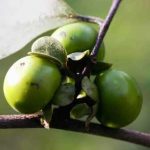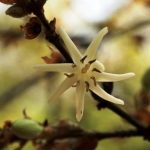TREE LIFE
JUNE 1991
MASHONALAND CALENDAR
Saturday 1st June: Botanic Garden Walk. Park your car at the Herbarium to meet Tom at 1045 hours for 1100 hours. I think Tom’s subject this month is ‘Figs’.
Sunday l6th June: Ngomokarira – meaning the hill of crying out — as always – something is lost in the translation but the loud sounds heard at night were said to come from the souls, living or dead who knows, of the witches sent to the mountain top to stop them hurting other human kind. In twentieth century parlance we could say a detention centre for persons displaying anti-social behaviour. When this took place the story tellers do not say, sometime between occupation by the lovely little bush people and the iron smelting fraternity who may have plied their craft there a little more than a century ago. Whatever the human history – someone in the last couple of hundred years must have destroyed over 90% of a unique montane forest flora at over 5200 ft. A mere fragment remains but enough to excite imagination.
Depending on demand on the day we could plan two separate parties, the less energetic to explore the ravine forest – the other to ascend the gorge above the ravine to look at the mountain top.
Saturday 22nd June: Walk with Mark at Cleveland Dam. Meet in the main car park at 1500 hours.
Saturday 7th July: Botanic Garden walk
MATABELELAND CALENDAR
Sunday 2nd June 1991: Conditions have dried out at Stone Hills, Marula. Meet at Grafotype, 81 Plumtree (Mafeking) Road, at 0830hours. Cars can be left under lock and key. All day — bring lunch and chairs. Richard and Bookie Peak will join us.
Wednesday 12th June: MCHEW – 5 pm at Hillside Dam
Sunday 16th June 1991: An extra – thanks to Bill Short/Peta Parrish for “discovering” the route to the Lumane Falls in the eastern Matopos. There may not be much water, but the views/trees . . . and we will probably have lunch at Diana’s Pool! All day. Meet at Clem’s house, 4 Carnarvon Road, Hillside (off Cecil Avenue/near TTC) where cars can be left under supervision – 0830 hours (Food/chairs).
Sunday 7th Jul 1991: Back to Pasipas and to the “threatened” completely different area on the high ridge behind Anne Visser’s house. Meet at Falls Road Motors at 0830 hours. Half day – bring tea and chairs.
Soma Esterhuizen
It is indeed with a sense of loss that we record the death of Soma Esterhuizen of Karoi. Soma was one of the most enthusiastic members of the Tree Society and bubbled over with such great excitement that all around her were filled with inspiration. She arranged a number of exciting tree days from her farm. For one of these outings Cheryl and I arrived through the rain with restless kids and a car that threatened mutiny. Soma’s warm hospitality led us to scores of smiling guests, plates of goodies and an unlimited supply of tea while Essie Eeterhuizen disappeared into Karoi to fix the ailing car. Besides their interest in botany the Esterhuizens run a pottery in which they have experimented with a wide variety of techniques from slab work to wheel work, from raku firing to many of their own clays and glazes. Their buttons and beads are well known from Zimbabwe all the way to the famous bead shop in Cape Town. My life has definitely been enriched by having spent time with the Esterhuizens, we extend our deepest sympathy to the family.
-Kim Damstra
EASTER 1991 – SHANGANI
Ken’s directions to Bon Accord Farm were impeccable and the 3 metre game fence and grid told us we had reached our destination. So we drove on to find the homestead. Several kilometres on, yet another game fence suggested that we had driven through the entire property and that finding our accommodation might be a problem. We turned back and took a track, the only one we had seen, which headed south. The terrain and road conditions varied considerably but generally worsened, nevertheless we saw a sign post to Bila Ruins confirmed we were still on Bon Accord so we pressed on bravely. Easing our way gently down a granite slope we bogged down to the axles a patch of sponge. A spade, brushwood and gravity helped us out, but a twenty metre stretch of deeply flooded track soon persuaded us that it would be prudent to turn back. So we headed for the first game fence where we had seen some thatchers to ask for directions. An hour after we had first entered the property we were back at square one, but with rather more mixed feelings about Ken’s directions! The worker pointed out the way and five minutes later we drew up at the homestead where Maureen and Shirley had settled in on the previous evening and where the Blake’s tent was pitched under a Parinari curatellifolia.
Bon Accord was for many years farmed by Helena Glasses and when she died in 1990 her sister Robyn Thompson sold the property to Jimmy Goddard. It is not a big place by Shangani standards but it is interesting and attractive and the higher rainfall of the area makes it floristically more akin to Mashonaland than to Matabeleland. The northern section has a typically central watershed terrain of broad shallow valleys dominated by grassland with interestingly varied islands of thicket vegetation on the termitaria. The low intervening ridges carry miombo woodland where Julbernardia globiflora and Brachystegia spiciformis are the main subjects. Southwards, the plateau breaks into a low but rugged escarpment with a much greater diversity of plants. Here Aloe excelsa and Brachystegia glaucescens abound. Views from the lip of the escarpment are spectacular and the middleveld plain stretches almost endlessly broken only by soaring granite domes such as Wabayi and Shangangwe. The ancients have used this country for millennia and there are numerous stoneage and iron age sites. The stone laager of Bila and its fascinating quarry stand on Bon Accord itself and from the granite ridge above this ruin one can see the splendid acropolis of Nalatala. The new plans for the farm include a combination of safari work (photographic) and environmental education. The entire property is game-fenced and giraffe, sable, wildebeast, eland, tsessebe, impala and zebra have been introduced. The purpose of our visit was to make a tree list for Jimmy Goddard.
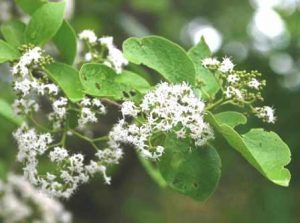
Ehretia amoena. Photo: Bart Wursten. Source: Flora of Zimbabwe
Serious botanizing started after lunch by which time the McNaughtans had arrived, and we worked in the vicinity of the farm house. Ekebergia benguelensis and Ehretia amoena were interesting and new discoveries for Bulawayo people, and using the tongue test, an innovative technique for us, we differentiated between Gardenia ternifolia and G. volkensii.
Much later we came upon Jimmy Goddard and a party of house guests in his Landcruiser. Introductions were made and we were invited aboard for a game viewing drive in the northern section of the farm. A profitable and enjoyable ride brought us back at dusk to find that the du Plessis family from Trelawney had arrived.
Saturday morning’s arrangements were to take us to the southern section and for this an old Ferguson tractor and its trailer were laid on. Initially we were dropped at the southern boundary in the Landcruiser and walked across country to rendezvous with the tractor. Not unexpectedly, we took much longer than the driver, Jabulani, expected so he came to fetch us. He then attempted to demonstrate the capabilities of his much loved vehicle on a one in-three boulder-strewn slope which caused Dave du Plessis great anguish. Our excursion added a substantial number of trees to the list and a Cussonia sapling provided controversy. Was it natalensis or arborea? Eventually Maureen got her way and went for the latter of the specific. Lunch was taken at the foot of Nalatale, but before this we had climbed its summit to admire and marvel at the view, the wonderful dry stonework (chevron patterns of chestnut coloured banded ironstone contrasting with pale grey granite) and some magnificent
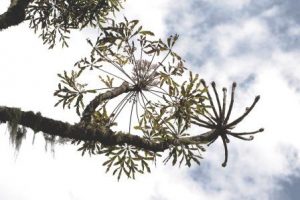
Cussonia spicata subsp. triptera. Photo: Bart Wursten. Source: Flora of Zimbabwe
Cussonia spicata subsp. triptera. Back at Bon Accord we were onto tractor and trailer again for another evening game drive.
On Easter Sunday morning the Goddards invited us to join them and their house party, firstly at an open air inter – denominational Communion at world’s View, Pezulu, and thereafter to a lamb-on-the-spit at the homestead. Some informal treeing at world’s View before the service and some more serious work after church gave us the basics of the Pezulu tree list and the richest diversity of species we were to find in the Shangani area. Lunch was a sumptuous affair but there was no time for post-prandial drowsing. It was back into the Landcruiser (21 of us!) and a hair raising eighty-kilometre an hour journey to Wabayi, a granite dome on Debshan Ranch, the northern-most roosting site of the Cape vulture. Climbing Wabayi was stiff work and Shirley Dodds and the Du Dlessis family were the only ones who made it to the beacon, Maureen and I nearly there. Rhus chirendensis was found at the foot of the bornhardt. I had last seen it in August in the forest of its name but failed to recognise it this time. We were back at Pezulu for drinks and steaming soup well after dark.
On Monday morning we added Combretum adenogonium (formerly fragrans ), C. collinum and C. apiculatum to our list which brought it up to 73 species for Bon Accord.
Work at world’s View and Fern Dam on Pezulu yielded 56 species. It was a truly splendid Easter. It was good to meet and work with our Harare people again and all of us were quite overwhelmed by the warmth and hospitality of the Goddard Family.
-Ian Mccausland
Some of the trees which impressed us by their size and repeated occurrence at Pezulu were Carissa edulis, Antidesma venosum, Brachylaena rotundata, Bridelia mollis, Canthium lactescens, Celtis africana, Dombeya rotundifolia, Dovyalis zeyheri, Ekebergia benguelensis, Erythrina lysistemon, Heteromorpha trifoliata, Mimusops zeyheri, and a favourite of the moment Cussonia spicata .
M.S .J.
MATABELELAND NOTES – MALEME ARBORETUM WALK — 5th MAY 1991
Up at dawn and straight away indulging in the usual hustle and bustle, packing foodstuffs, ice and drinks and all the trappings necessary for a day in the bush. Don’t forget field cards, collecting bag and binoculars. Off we go at 0800 hours to rendezvous with the other Tree Society members, the warmth of our greetings compensating for the rather chilly nip prevailing in the early mornings at this time of year.
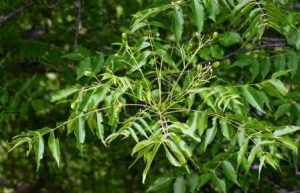
Kirkia acuminata. Photo: Bart Wursten. Source: Flora of Zimbabwe
It is a clean, golden morning and the drive through the Matopos always provides balm for the soul. The trees are undergoing their magic metamorphosis to autumn colours and the huge rock dwalas look like giant rockeries covered with gold, red, green, grey, orange and pink trees, interspersed here and there by Euphorbia cooperi or E. ingens for added interest. An Impala ram lifts his head and gazes at us serenely as we pass, the rest of his herd grazing peacefully further back. A family of warthog scuttle off from the side of the road, their tails straight up like periscopes, and run swiftly into the long grass.
All too soon we reach our destination at the far reaches of Maleme Dam where we park our vehicles and start on the Arboretum “walk” – a misnomer. This “walk” as we soon discover consists of climb, slither, hoist, crawl and pant (surreptitiously of course.) The expedition was prompted by Geoff. I’m not going to tell you Geoff Archer’s age as I don’t believe in such disclosures for good reasons but suffice to say that he is the Klipspringer of our Society’ and had to contend with many wails of complaint at varying stages of the expedition. Fortunately the trees in great variety of species and colour make up for it all. Most noticeable for a start there are many Kirkia acuminata in full autumn glory, soon to be rivalled by Albizia tanganyicensis on the higher slopes. A sudden descent brings us into a glade where we find Acacia karroo, A. nilotica and A. rehmanniana. Then into a swampy area where we disappear into the long grass and only heads are visible. Here we find Combretum erythrophyllum. Later we also find C. apiculatum and C. hereroense. Through a narrow gap between two giant boulders and up an irregular staircase along which are growing Ehretia rigida, Mundulea sericea, Pappea capensis, Pouzolzia mixta, Ochna glauca, Tradenia brevispicata, Crossopteryx febrifuga, lots of Brachylaena rotundata and one or two B. huillansis.
Suddenly several bodies crouch down over an interesting moving object. Curious as ever, I join the group and find a large, shiny white caterpillar about 3 inches long and thick as my thumb. It appears to consist of several ivory rings glued together but the interesting feature is that it is walking on its back with all its legs up in the air. Someone suggests that they are horns and not legs, so I turn him over with all his feet on the ground. Nothing on the other side. Promptly the creature turns over on his back and continues off over the black, composty soil, legs flailing the air.
Up ahead Ian thinks he has found Vernonia colorota but Geoff is not so sure. We take a breather under a Pseudolachnostylis maprouneifolia which has not yet started to change colour and then, following the white arrows, we set off up an almost perpendicular rock face. A quarter or the way up I feel my feet slide out from under me and I begin an undesired decant somewhat faster than anticipated! Margaret, coming up behind me, shouts a warning as to a heap of fresh baboon’s mess directly in my slithering path. But it is duly scooped up before I bring myself to an embarrassing halt. With a silent verbal broadside directed at the missing perpetrator I recommence my ascent on all fours and finally make a somewhat shame faced appearance on the higher slopes.
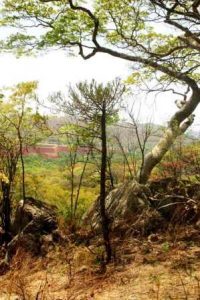
Euphorbia griseola. Photo: Bart Wursten. Source: Flora of Zimbabwe
The view now becomes spectacular and in some of the soil filled cracks and crannies we find Elephantorrhiza goetzei and Euphorbia griseola. On and on upwards, while something inside me apprehensively contemplates the nature of an unavoidable descent
we find a magnificent Ficus ingens. Others of the species seen later include F. abutifolia, F. cordata, F. glumosa, F. sur, F. tettensis and F. thonningii. We finally arrive at the summit which has taken the best part of two hours. To the northwest is lnungu nature beckons the Cross of Christ, below snakes the Malene River, the dam out of sight to the south east, and now we turn to follow the arrows on the return journey. Ahead stretches a huge saddle of solid rock linking the dome where we are with the one above the dam which we have to traverse before making our descent. Betty points out the black eagles circling above. There are two of them, soaring in a display. Below somewhere there is a purple crested lourie honking to his heart’s content. Then we hear the plaintive, falling notes of the green spotted dove, but fail to locate it.
Great pleasure expressed all round when we find Entandrophragma caudatum and the ground littered with peeled “wooden banana”. Crossing this great rock saddle is a pleasant experience, views all round are widely magnificent and the chaotic grandeur of the Matopo vary impressive. We came across Commiphora marlothii, having earlier seen C. mollie. lan introduces me to Tarchonanthus camphorates and I am pleased to make its acquaintance. I am treated to a learned dissertation among our literati as to the pronunciation of some of the botanical names. That reminds me – is it “Feecus” or “Fie-cus?”.
We now commence our descent. After a false start we come upon the remains of an ancient construction. Did the builders of the Zimbabwe Ruins live in the Matopos Hills first or did they attempt a settlement there afterwards? Still contemplating this conundrum, I follow Betty and Albert on what turns out to be a hair raising descent. We arrive at a point where we have to decide whether to take the left hand arrow or the right. Geoff now puts in an appearance and suggests the left. Soon I wish I had not taken his advice and rather gone on the short-cut to the right. Several slithers later I find myself perched on a rock ledge. A sheer drop to the left of some sixty feet where more rocks jut out over the water. A rock roof to the right forming a shallow cave and Ian in front, sitting on the narrow ledge with his legs dangling ever the edge. Nowhere else to go. “I have no head for heights,” says Ian. I assure him that the debility is mutual and watch his progress with trepidation. With back arched under the rock roof and feet dangling in the void, we inch our way on our bottoms to the end where there in a slight broadening of the ledge. One slip…… Let us not, however, think on such things. As soon as the deadly hazard in behind us, we find more trees to occupy our minds. Cordia grandicalyx, Cassia abbreviata, Flacourtia indica, resplendent in orange and red, Ximenia caffra, Sclerocarya birrea, Turraea obtusifolia, Homalium dentatum and so many others.
Several steep descents later we come upon a woodland path well colonised by Croton gratissimus, Strychnos matopensis and Pittosporum viridiflorum. Four hours after setting out on our walk, we arrive gratefully back at base a little the worse for wear but enriched by an unforgettable experience. As always I feel somewhat chastened by the immensity and diversity of creation. We recorded 95 species of trees identified on the walk. Thank you Ken and Betty.
-CLEM VAN VLIET.
McHEW – l5th MAY, 1991
…. And still they came…. with a turnout of members like this we are beginning to wonder whether Ian or the trees are the attraction. The subject this month was “seed cases” and going from the Combretum apiculatum to C. molle (very different leaves) to C. imberbe and on to C. hereroense was quite exciting as members were trying to out guess Ian! As the evenings are drawing in, we only had six trees for the subject, the last two conveniently side by side were the Terminalia sericea and T. trichopoda. Two good choices to compare the four-winged against the flat seeds.
It was great to hear Charles putting his oar in — first time out since his operation and when Geoff speaks and we are “all ears”, he reminds me of Oliver Goldsmith’s Village Schoolmaster – “And still they gazed, and still the wonder grew, that one small head could carry all he knew”.
Thank you Ian, you didn’t short – change us — we had our money’s worth.
-KEN BLAKE
NYARUPINDA CATCHMENT MAY 1991
On the tree day here last year we walked in woodland approximately 100 hectares, in extent. This area is sufficient for birds endemic to Brachystegia country to breed, here are some of them:- Spotted Creeper only in April 1990 and this April as yet; a fidgety Chat; Miombo Rock Thrush comes in winter to drink, Barbets call and Lizard Buzzards watch and wait. A gray Penduline Tit’s nest (vacated) hangs among leaves and fruit of Pseudolachnostylis sp. on stoney ground at the dam, what a beautiful nest. It is 6.15 pm the freckled nightjar is punctual.
In the small hours, awake: Grey Duiker cropping Euphorbia heterophylla (annual wild poinsettia) in the Rhomed land; white faced Owl calling purr—r-r-ow-co; Spotted Eagle Owl; another sleeper in the room 7.. a Barn Owl on the ledge above the window; a snatch of wood Owl’s call. Fiery necked Nightjars are noisy before retiring. A jackal upsets the dogs, Swainson’s Francolin wakes up the Turtle Doves and Kingfishers of the woodland. Mercifully the wakey-—wakey birds have overslept. Cosmos flowers, in the grass, face the rising sun.
Milk Cells in Trees, Shrubs, Lianes and Herbs.
The moment the surface of a latex-bearing plant is broken, ‘milk’ wells up, it has been forced out of damaged latex tubes which have elastic walls. Differentiated in the embryo, these laticiferous cells grow as the plant grows and permeate all the tissues. These simple or branched tubes may attain a length of more than a metre, they are the longest cells in the plant kingdom. Latex may occur in columns of cells or in layers.
A description of all the possible constituents would fill a book, e.g. alkaloids, grains of starch and protein, sugars, enzymes, gum-resins, fats and oil. Globules of rubbery substances in emulsified form give it its milky appearance. In addition to this sticky fluid, do these plants have normal sap in their living cells – the answer must be yes …
Research on latex suggests that its role inside the plant is to isolate toxic waste, to fix water to counter water stress, and to enable distribution of substances by dissolving them, the whole story is not yet known.
Externally the ‘milk may be a caustic or poisonous protection for the plant’s survival, to make it distasteful. Veld-poisoning may occur when famine forces animals to eat these plants. Exuded latex coagulates and makes a covering for all kinds of wounds. Wound gum in trees, mentioned last month, has a different origin but serves the same purpose, a seal.
It is best to skip the economic and ornamental importance of latex plants in favour of their universal use for primitive hunting, shooting and fishing, as bait, arrow and fish poison. Sticky sap captures very small birds when they are lured to twigs twirled in boiled latex, murimbo, birdlime is collected from slanting chops on the trunk of a ‘milk’ tree, e.g. Ficus stuhlmannii. It is important to identify poisonous species, their sap is potent and all parts of these plants should be handled with care.
‘Milk’ Plants in the Catchment: Latex is diagnostic for some or all of the genera in the following families of plants. Here they are in a likely evolutionary sequence, Kim has mentioned several criteria in Tree Life No. 118.
MORACEAE fig and mulberry family. Figs need no introduction except to say that their ‘milk’ is comparatively mild and is used by herbalists for treating burns, also inflammation of eyes and throat. Probably Ficus sycomorus fruits are the best wild figs. Perhaps California syrup of Figs is memorable for some of us. Mulberries are native to Asia, they are garden escapees when found in the bush, silk worms feed voraciously on mulberry leaves.
PAPAVERACEAE Yellow flowered prickly poppy called Argemone is a weed of waste ground near farm buildings. Is its orange sap opaque or clear?
EUPHORBIACEAE is a family of surprises, its members are all shapes and sizes. Euphorbia is its largest genus, represented here by two lawn weeds, caudiciform euphorbia decidua, E. schinzii, E. ingens (candelabra tree), E. matabelensis which is giraffe food at Audley End farm, E. tirucalli, rubber hedge, is planted near ‘musha’ on the estate. Their latex is copious, often with high rubber content and frequently poisonous. There are seven more genera of this family here but they have ordinary sap.
CARICACEAE contains the pawpaw, Carica papaya. A creamy exudate soon dries white on the young fruit after being sand-blasted by a dust storm. This crust contains the enzyme papain which acts on protein. Papain is in stems and foliage, this explains the traditional use of pawpaw leaves for wrapping meat to tenderise it.
SAPOTACEAE a milk plum family, stem fruit jelly will be a novelty if we can find enough fruit, we will be competing for it with monkeys, wild pig, birds and insects. Mimusops zeyheri fruit is edible, all sapote berries contain vitamin C. The quantity of latex may be seasonal, it has been a basis for chewing gum and water proofing products, mostly synthesised nowadays.
The milky way continues with APOCYNACEAE frangipani family which includes Carissa edulis, Diplorhynchus sp. (wild rubber tree) and Holarrhena pubescens. Should ripe Carissa berries be given to a pregnant African woman, they would help to make milk, not directly but by acting as a vermifuge, so improving her metabolism. Rubber tree, despite its latex is browsed by eland and smaller antelope, far beyond the catchment it is eaten by two of the Big Five, i.e. elephant and black rhino. Some African people eat the caterpillar “nhowa’’ which feeds on Diplorhynchus, perhaps Rob Pare mentioned the name of the adult butterfly/moth. At the moment Holarrhena bears long narrow paired pods (follicles), all parts have milky sap. The specific name was febrifuga, the medicine is in the grey, deeply fissured, corky bark, wherever the tree occurs, Southern Africa, India and Burma.
A captive Save Star is a deciduous exception in this essentially evergreen family. The exotic shrub Oleander is a very poisonous plant, children beware.
ASCLEPIADACEAE the milkweed family
The sight of succulent Stapelia among rocks in arid places is a vague memory but Sarcostemma, Caropegia and vlei Asclepias (bright orange flowers) are easy to remember, but difficult to find, leaves and flowers are characteristically sparce. Some South African tribes eat raw Satcostemma. Masai chew it as a thirst quencher, livestock may die from it. “Food Plants of Zimbabwe” informs us that tubers of Ceropegia are a source of water, they may be eaten cooked or raw, any left overs may be worn as a good luck charm. It is sinful to abuse them like this because they have flowers of varied colour patterns and fantastic shape. A homely Ceropegia which does not spend nine months under ground is lantern plant alias hearts and candles which has bead like tubers and slender nearly black flowers, so it is a popular pendulous pot plant, what a tongue twister. Most Ceropegias are soft stemmed twiners.
CONVOLVULACEAE sweet potato and morning glory family, to which Lepistemon shirensis (from the Shire river) belongs, this is the catchment’s new bloom liane show piece during April and May. There is only one plant, it is rare because its environment has been destroyed. Ipomoea batatas leaves when cooked in water in which maize has been boiled are used medicinally to increase human milk. Identification of species of Ipomoea shows that some leaves and tubers are food, some medicinal and others poisonous.
Compos….. no! ASTERACEAE daisy family, the largest family of all, but very few trees and only two genera with latex, namely Senecio and Sonchus, lettuce and sow thistle respectively, these thrive on irrigation. Both of these are edible when young but soon older leaves are bitter with latex.
With regard to poisonous plants the toxicity of species may vary from one year to another, from the young plant to the adult, and also from one locality to another.
Do you feel a bit muzzy after concentrating on all that? Was it Greek to you? That is good. Here is some more pertinent Greek – the word ‘lacca’ as in Phytolacca is Greek for dye but sounds like milk. There is a family of milk worts, POLYGALACEAE the genus Polygala is derived from the Greek, much milk. At one time it was considered that it stimulated cows to lactate, thus it does have lacticiferous connotations.
The ecological tapestry will be described next month. Happy treeing the Milky way.
Behind the Dairy Den in Chisipite can be found the new and interesting Zambesi Society Shop. The shop which is being run by Mr Ian Sinclair (whose telephone No. is 45569) will sell a wide variety of local crafts including leather work, stitchcraft and wall hangings as well as healthy and well established indigenous tree seedlings. Certainly worth investigating.
-Benedicta graves
KIM DAMSTRA CHAIRMAN


